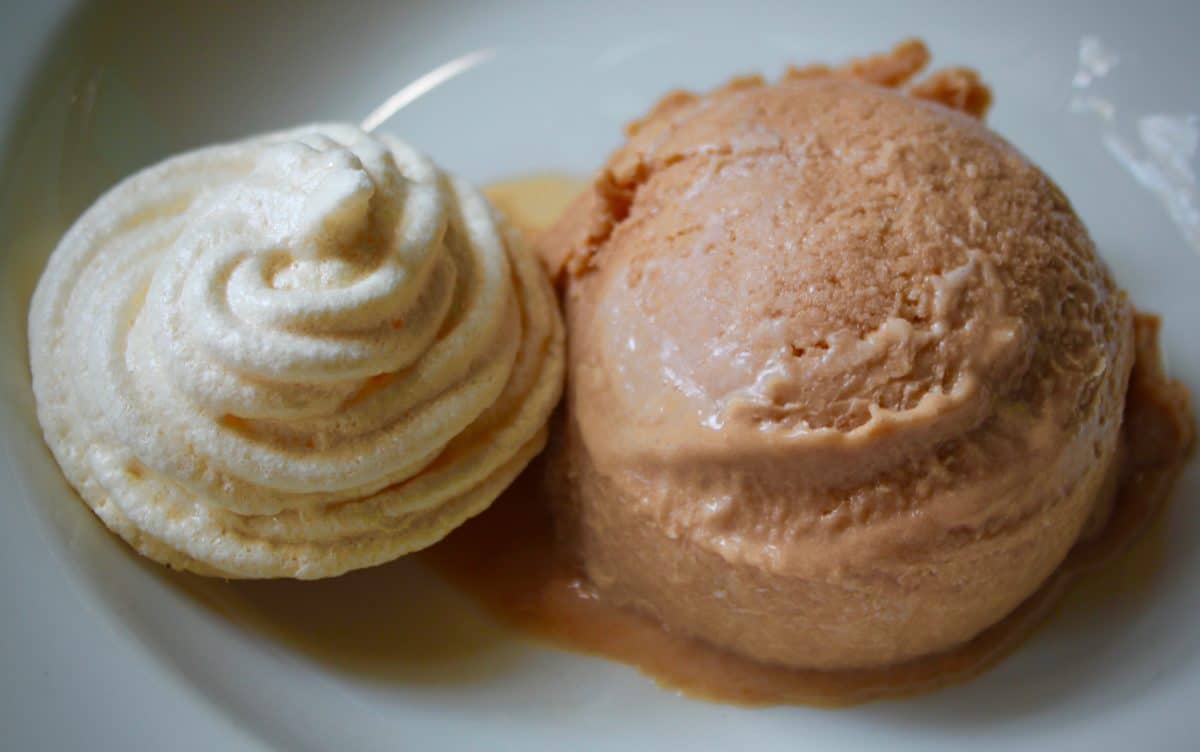Copyright Annabel Hughes & SavannaBel – www.savannabel.com.
Ingredients
For the wild sourplum syrup:
- •1 kg (2.2 pounds) sourplums* (or cranberries or tallow plums or other red sour fruit), rinsed and drained
- •1 kg (2.2 pounds) granulated sugar
- •* The quantity of fruit may vary; use equals parts fruit and sugar.
For the ice cream:
- •450 ml (15 fl ounces) double (heavy) cream
- •150 ml (5 fl ounces) whole milk
- •6 egg yolks
- •65 grams (2.3 ounces) caster (superfine) sugar
- •237 ml (8 fl ounces) sourplum syrup
For the meringue:
- •Coconut oil, for greasing (optional)
- •6 egg whites, at room temperature
- •Pinch of salt
- •300 grams (11 ounces) caster (superfine) sugar
- •2.5 ml (½ teaspoon) vanilla extract
If you don’t have access to sourplums, any sour red fruit, like cranberries, turned into a syrup will work well with this recipe. In the United States, Ximenia americana, or tallow plum, is found in Florida and other dry, semi-arid areas through the south and west.


Preparation
For the wild sourplum syrup: Mix the fruit and sugar in a heavy-based saucepan, cover with water and bring to a boil. Reduce heat and simmer until the fruit has softened and the juice thickened to a syrup, about 2 hours. Remove from the heat, and strain the fruit out of the syrup, reserving the syrup. Set aside until ready for use.
For the ice cream: Put an ice cream container and metal mixing bowl into the freezer. Combine the cream and milk in a heavy-based pan over medium heat. Bring to a gentle boil, stirring occasionally. Meanwhile, beat the egg yolks and sugar together in a medium bowl until the mixture turns pale and thick.
When the milk mixture is at a boil, slowly pour it over the egg yolk mixture while whisking vigorously. Return custard to the saucepan over very low heat. Stir gently, moving all around the saucepan, until the custard thickens, 6 to 8 minutes. (Note: Controlled heat is essential at this stage because the custard will quickly turn to scrambled egg if the heat is too high. The custard should be thick enough to lightly coat the back of a wooden spoon.)
As soon as the custard thickens, remove from the heat, pour into the chilled mixing bowl, and return it to the freezer for a few minutes. When the custard is cool, whisk in 237 ml (8 fluid ounces) of the sourplum syrup (reserve remainder for another use). Freeze using an ice cream maker, transfer to the ice cream container, and store in the freezer until ready to serve.
For the meringue: Preheat the oven to 150°C (300°F). Line a baking tray/sheet with parchment paper or nonstick liner, or lightly grease with coconut oil. Place the egg whites and a pinch of salt in the bowl of an electric mixer. Beat slowly until frothy, then increase speed and beat until stiff, adding sugar, a heaped spoonful at a time, after each addition. Add vanilla extract and beat just to combine.
6 Transfer the meringue into a piping bag with a fluted nozzle. Pipe the meringues into shapes of your choice. Be sure to leave enough space for each meringue to expand. Place in the middle of the oven and immediately lower the oven setting to 120°C (250°F). Bake for 45 minutes, then turn off the oven and leave the meringues inside to cool completely.
To serve, arrange each meringue with a scoop of wild sour plum ice cream.

